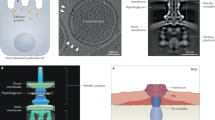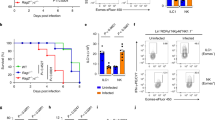Abstract
The mouse response to Salmonella Typhimurium infection is partly controlled through detection of the bacterium lipopolysaccharide by the host pattern recognition receptor, Toll-like receptor 4 (Tlr4). Mice deficient in Tlr4 signaling are extremely susceptible to Salmonella infection with a 1000-fold reduction in LD50. In a previous study, we showed, using transgenic mice carrying one, three, six and >30 copies of Tlr4, that the level of expression of this gene influences the outcome of Salmonella infection, with a plateau effect starting at three copies. In the present study, we further investigate the impact of Tlr4 during Salmonella infection in mice expressing Tlr4 at slightly sub-normal, normal and slightly supra-normal levels by comparing host responses in mice carrying one, two and three copies of Tlr4 on the same genetic background. We describe in detail the in vivo host response to pathogenic Salmonella and show for the first time, in this narrow range of Tlr4 expression, an incremental protective effect against Salmonella due to improved control of bacterial growth in target organs and increased expression of important immune response genes in the spleen.
This is a preview of subscription content, access via your institution
Access options
Subscribe to this journal
Receive 6 digital issues and online access to articles
$119.00 per year
only $19.83 per issue
Buy this article
- Purchase on Springer Link
- Instant access to full article PDF
Prices may be subject to local taxes which are calculated during checkout







Similar content being viewed by others
References
Janeway CAJ, Medzhitov R . Innate immune recognition. Annu Rev Immunol 2002; 20: 197–216.
Lewis T . Germs. N Engl J Med 1972; 287: 553–555.
Moore JN . A perspective on endotoxemia. Proceedings of the 47th Annual Convention of the American Association of the Equine Practitioners, San Diego, CA, 2001, pp 61–74.
Lemaitre B, Nicolas E, Michaut L, Reichhart JM, Hoffmann JA . The dorsoventral regulatory gene cassette spatzle/Toll/cactus controls the potent antifungal response in Drosophila adults. Cell 1996; 86: 973–983.
Medzhitov R, Preston-Hurlburt P, Janeway Jr CA . A human homologue of the Drosophila Toll protein signals activation of adaptive immunity. Nature 1997; 388: 394–397.
Poltorak A, He X, Smirnova I, Liu MY, Huffel CV, Du X et al. Defective LPS signaling in C3H/HeJ and C57BL/10ScCr mice: mutations in Tlr4 gene. Science 1998; 282: 2085–2088.
Qureshi ST, Lariviere L, Leveque G, Clermont S, Moore KJ, Gros P et al. Endotoxin-tolerant mice have mutations in Toll-like receptor 4 (Tlr4). J Exp Med 1999; 189: 615–625.
Akira S, Takeda K . Toll-like receptor signalling. Nat Rev Immunol 2004; 4: 499–511.
O’Brien AD, Rosenstreich DL, Scher I, Campbell GH, MacDermott RP, Formal SB . Genetic control of susceptibility to Salmonella typhimurium in mice: role of the LPS gene. J Immunol 1980; 124: 20–24.
Qureshi ST, Lariviere L, Sebastiani G, Clermont S, Skamene E, Gros P et al. A high-resolution map in the chromosomal region surrounding the Lps locus. Genomics 1996; 31: 283–294.
Rosenberger CM, Scott MG, Gold MR, Hancock RE, Finlay BB . Salmonella typhimurium infection and lipopolysaccharide stimulation induce similar changes in macrophage gene expression. J Immunol 2000; 164: 5894–5904.
Royle MC, Totemeyer S, Alldridge LC, Maskell DJ, Bryant CE . Stimulation of Toll-like receptor 4 by lipopolysaccharide during cellular invasion by live Salmonella typhimurium is a critical but not exclusive event leading to macrophage responses. J Immunol 2003; 170: 5445–5454.
Bihl F, Salez L, Beaubier M, Torres D, Lariviere L, Laroche L et al. Overexpression of Toll-like receptor 4 amplifies the host response to lipopolysaccharide and provides a survival advantage in transgenic mice. J Immunol 2003; 170: 6141–6150.
Vidal S, Tremblay ML, Govoni G, Gauthier S, Sebastiani G, Malo D et al. The Ity/Lsh/Bcg locus: natural resistance to infection with intracellular parasites is abrogated by disruption of the Nramp1 gene. J Exp Med 1995; 182: 655–666.
Vazquez-Torres A, Vallance BA, Bergman MA, Finlay BB, Cookson BT, Jones-Carson J et al. Toll-like receptor 4 dependence of innate and adaptive immunity to Salmonella: importance of the Kupffer cell network. J Immunol 2004; 172: 6202–6208.
Mebius RE, Kraal G . Structure and function of the spleen. Nat Rev Immunol 2005; 5: 606–616.
Jenner RG, Young RA . Insights into host responses against pathogens from transcriptional profiling. Nat Rev Microbiol 2005; 3: 281–294.
Jouanguy E, Doffinger R, Dupuis S, Pallier A, Altare F, Casanova JL . IL-12 and IFN-gamma in host defense against mycobacteria and salmonella in mice and men. Curr Opin Immunol 1999; 11: 346–351.
Roach JC, Glusman G, Rowen L, Kaur A, Purcell MK, Smith KD et al. The evolution of vertebrate Toll-like receptors. Proc Natl Acad Sci USA 2005; 102: 9577–9582.
Mastroeni P . Immunity to systemic Salmonella infections. Curr Mol Med 2002; 2: 393–406.
Bao S, Beagley KW, France MP, Shen J, Husband AJ . Interferon-gamma plays a critical role in intestinal immunity against Salmonella typhimurium infection. Immunology 2000; 99: 464–472.
Hess J, Ladel C, Miko D, Kaufmann SHE . Salmonella typhimurium aroA- infection in gene-targeted immunodeficient mice. J Immunol 1996; 156: 3321–3326.
Mastroeni P, Harrison JA, Robinson JH, Clare S, Khan S, Maskell DJ et al. Interleukin-12 is required for control of the growth of attenuated aromatic-compound-dependent salmonellae in BALB/c mice: role of gamma interferon and macrophage activation. Infect Immun 1998; 66: 4767–4776.
Lehmann J, Bellmann S, Werner C, Schroder R, Schutze N, Alber G . IL-12p40-dependent agonistic effects on the development of protective innate and adaptive immunity against Salmonella enteritidis. J Immunol 2001; 167: 5304–5315.
Hotchkiss RS, Karl IE . The pathophysiology and treatment of sepsis. N Engl J Med 2003; 348: 138–150.
Hotchkiss RS, Swanson PE, Freeman BD, Tinsley KW, Cobb JP, Matuschak GM et al. Apoptotic cell death in patients with sepsis, shock, and multiple organ dysfunction. Crit Care Med 1999; 27: 1230–1251.
Bommhardt U, Chang KC, Swanson PE, Wagner TH, Tinsley KW, Karl IE et al. Akt decreases lymphocyte apoptosis and improves survival in sepsis. J Immunol 2004; 172: 7583–7591.
Hotchkiss RS, Tinsley KW, Swanson PE, Chang KC, Cobb JP, Buchman TG et al. Prevention of lymphocyte cell death in sepsis improves survival in mice. Proc Natl Acad Sci USA 1999; 96: 14541–14546.
John B, Rajagopal D, Pashine A, Rath S, George A, Bal V . Role of IL-12-independent and IL-12-dependent pathways in regulating generation of the IFN-gamma component of T cell responses to Salmonella typhimurium. J Immunol 2002; 169: 2545–2552.
Arbour NC, Lorenz E, Schutte BC, Zabner J, Kline JN, Jones M et al. TLR4 mutations are associated with endotoxin hyporesponsiveness in humans. Nat Genet 2000; 25: 187–191.
Agnese DM, Calvano JE, Hahm SJ, Coyle SM, Corbett SA, Calvano SE et al. Human toll-like receptor 4 mutations but not CD14 polymorphisms are associated with an increased risk of gram-negative infections. J Infect Dis 2002; 186: 1522–1525.
Lorenz E, Mira JP, Frees KL, Schwartz DA . Relevance of mutations in the TLR4 receptor in patients with gram-negative septic shock. Arch Intern Med 2002; 162: 1028–1032.
Mockenhaupt FP, Cramer JP, Hamann L, Stegemann MS, Eckert J, Oh NR et al. Toll-like receptor (TLR) polymorphisms in African children: common TLR-4 variants predispose to severe malaria. Proc Natl Acad Sci USA 2006; 103: 177–182.
Rezazadeh M, Hajilooi M, Rafiei A, Haidari M, Nikoopour E, Kerammat F et al. TLR4 polymorphism in Iranian patients with brucellosis. J Infect (in press).
Brand S, Staudinger T, Schnitzler F, Pfennig S, Hofbauer K, Dambacher J et al. The role of Toll-like receptor 4 Asp299Gly and Thr399Ile polymorphisms and CARD15/NOD2 mutations in the susceptibility and phenotype of Crohn's disease. Inflamm Bowel Dis 2005; 11: 645–652.
Barber RC, Aragaki CC, Rivera-Chavez FA, Purdue GF, Hunt JL, Horton JW . TLR4 and TNF-alpha polymorphisms are associated with an increased risk for severe sepsis following burn injury. J Med Genet 2004; 41: 808–813.
Kiechl S, Lorenz E, Reindl M, Wiedermann CJ, Oberhollenzer F, Bonora E et al. Toll-like receptor 4 polymorphisms and atherogenesis. N Engl J Med 2002; 347: 185–192.
Hawn TR, Verbon A, Janer M, Zhao LP, Beutler B, Aderem A . Toll-like receptor 4 polymorphisms are associated with resistance to Legionnaires’ disease. Proc Natl Acad Sci USA 2005; 102: 2487–2489.
Minoretti P, Gazzaruso C, Vito CD, Emanuele E, Bianchi M, Coen E et al. Effect of the functional toll-like receptor 4 Asp299Gly polymorphism on susceptibility to late-onset Alzheimer's disease. Neurosci Lett 2006; 391: 147–149.
Poltorak A, Smirnova I, Clisch R, Beutler B . Limits of a deletion spanning Tlr4 in C57BL/10ScCr mice. J Endotoxin Res 2000; 6: 51–56.
Malo D, Vogan K, Vidal S, Hu J, Cellier M, Schurr E et al. Haplotype mapping and sequence analysis of the mouse Nramp gene predict susceptibility to infection with intracellular parasites. Genomics 1994; 23: 51–61.
Min-Oo G, Fortin A, Tam MF, Gros P, Stevenson MM . Phenotypic expression of pyruvate kinase deficiency and protection against malaria in a mouse model. Genes Immun 2004; 5: 168–175.
Pfaffl MW, Tichopad A, Prgomet C, Neuvians TP . Determination of stable housekeeping genes, differentially regulated target genes and sample integrity: BestKeeper – Excel-based tool using pair-wise correlations. Biotechnol Lett 2004; 26: 509–515.
Ramakers C, Ruijter JM, Deprez RH, Moorman AF . Assumption-free analysis of quantitative real-time polymerase chain reaction (PCR) data. Neurosci Lett 2003; 339: 62–66.
Pfaffl MW, Horgan GW, Dempfle L . Relative expression software tool (REST) for group-wise comparison and statistical analysis of relative expression results in real-time PCR. Nucleic Acids Res 2002; 30: e36.
Acknowledgements
This work was supported by grants from the Canadian Institutes of Health Research (CIHR) and the Howard Hughes Medical Institutes (HHMI). MF Roy was the recipient of a CIHR fellowship. D Malo is a William Dawson scholar.
Author information
Authors and Affiliations
Corresponding author
Additional information
Disclosure: The authors have no competing financial interests.
Supplementary Information accompanies the paper on Genes and Immunity's website (http://www.nature.com/gene)
Supplementary information
Rights and permissions
About this article
Cite this article
Roy, MF., Larivière, L., Wilkinson, R. et al. Incremental expression of Tlr4 correlates with mouse resistance to Salmonella infection and fine regulation of relevant immune genes. Genes Immun 7, 372–383 (2006). https://doi.org/10.1038/sj.gene.6364309
Received:
Revised:
Accepted:
Published:
Issue Date:
DOI: https://doi.org/10.1038/sj.gene.6364309
Keywords
This article is cited by
-
Overexpression of Toll-like receptor 4 contributes to the internalization and elimination of Escherichia coli in sheep by enhancing caveolae-dependent endocytosis
Journal of Animal Science and Biotechnology (2021)
-
Genetically modified "obligate" anaerobic Salmonella typhimurium as a therapeutic strategy for neuroblastoma
Journal of Hematology & Oncology (2015)
-
Impact of Usp18 and IFN signaling in Salmonella-induced typhlitis
Genes & Immunity (2011)
-
Complexity in the host response to Salmonella Typhimurium infection in AcB and BcA recombinant congenic strains
Genes & Immunity (2006)



